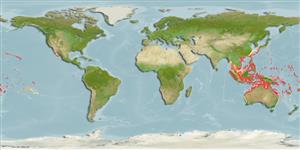Environment: milieu / climate zone / rango de profundidad / distribution range
Ecología
marino asociado a arrecife; rango de profundidad 1 - 60 m (Ref. 1602). Tropical; 35°N - 35°S, 95°E - 125°W (Ref. 47838)
Indo-Pacific: East Africa (south to Port Alfred, South Africa, Ref. 5372) to the Hawaiian, Marquesan, and Ducie islands, north to southern Japan, south to the Lord Howe and Rapa islands; throughout Micronesia.
Tamaño / Peso / Age
Madurez: Lm ? range ? - ? cm
Max length : 20.0 cm TL macho / no sexado; (Ref. 9710); common length : 16.0 cm TL macho / no sexado; (Ref. 48636)
Espinas dorsales (total) : 12 - 13; Radios blandos dorsales (total) : 19 - 23; Espinas anales: 3; Radios blandos anales: 18 - 20.
Body shape (shape guide): short and / or deep; Cross section: compressed.
Occur in small groups in reef flats, clear lagoon and seaward reefs (Ref. 48636). Benthopelagic (Ref. 58302). Feed on soft and hard corals, also on polychaetes, small crustaceans, and filamentous algae. In Indonesia, usually seen at moderate depths, usually swimming in small groups. Adults are mainly in depth 20-60 m (Ref. 48636). Oviparous (Ref. 205), monogamous (Ref. 52884). Form pairs during breeding (Ref. 205).
Life cycle and mating behavior
Madurez | Reproducción | Puesta | Huevos | Fecundidad | Larva
Distinct pairing (Ref. 205). Monogamous mating is observed as both obligate and social (Ref. 52884).
Myers, R.F., 1991. Micronesian reef fishes. Second Ed. Coral Graphics, Barrigada, Guam. 298 p. (Ref. 1602)
IUCN Red List Status (Ref. 130435: Version 2025-1)
Threat to humans
Harmless
Human uses
Pesquerías: escaso valor comercial; Acuario: Comercial
Herramientas
Special reports
Download XML
Fuentes de Internet
Estimates based on models
Preferred temperature (Referencia
123201): 24.3 - 28.8, mean 27.6 °C (based on 518 cells).
Phylogenetic diversity index (Referencia
82804): PD
50 = 0.5000 [Uniqueness, from 0.5 = low to 2.0 = high].
Bayesian length-weight: a=0.02818 (0.01692 - 0.04693), b=3.00 (2.86 - 3.14), in cm total length, based on LWR estimates for this species & Genus-body shape (Ref.
93245).
Nivel trófico (Referencia
69278): 3.3 ±0.3 se; based on diet studies.
Resiliencia (Referencia
120179): Alto, población duplicada en un tiempo mínimo inferior a 15 meses (Preliminary K or Fecundity.).
Fishing Vulnerability (Ref.
59153): Low vulnerability (10 of 100).
🛈
Nutrients (Ref.
124155): Calcium = 85.1 [45.0, 130.0] mg/100g; Iron = 0.753 [0.453, 1.216] mg/100g; Protein = 18.6 [17.5, 19.7] %; Omega3 = 0.122 [0.077, 0.193] g/100g; Selenium = 36.2 [20.8, 66.5] μg/100g; VitaminA = 48.7 [14.5, 161.6] μg/100g; Zinc = 1.3 [0.9, 1.8] mg/100g (wet weight);
